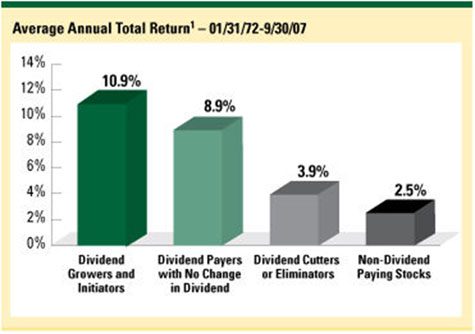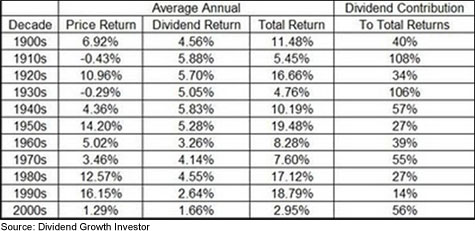Do Dividend-paying Stocks Outperform Non-dividend Paying Stocks Over Time?
Companies / Dividends Jan 15, 2010 - 01:18 PM GMTBy: Sean_Brodrick
 Many stock analysts will tell you the basic strategy in the market is to buy low and sell high. While I’ve done that successfully for years, it’s not as easy as it sounds. What’s more, it’s a lot more difficult in bear markets and markets bound in trading ranges, which are two distinct possibilities going forward.
Many stock analysts will tell you the basic strategy in the market is to buy low and sell high. While I’ve done that successfully for years, it’s not as easy as it sounds. What’s more, it’s a lot more difficult in bear markets and markets bound in trading ranges, which are two distinct possibilities going forward.
So an alternative might be to PARTNER with companies — and you do that by buying stock in companies that pay you regular cash dividends.
That’s the basic principle behind dividend paying stocks, one that is absolutely crucial — they pay YOU to own THEM.
Do dividend-paying stocks outperform non-dividend paying stocks over time?
The answer to this question is “it depends on your time frame.” If you compared the two during the go-go days of the tech bubble, dividend paying stocks were left in the dust. However …
In most markets, dividend paying stocks do at least as well as non-dividend paying stocks, once you add dividends back in, and in bearish or underperforming markets, dividend paying stocks can really outperform.
In 2008, Ned Davis Research published a chart showing just this going back to 1972. It clearly shows that stocks that are dividend payers outperform the non-payers over a longer time period.
 |
The return differences result in dramatic differences in the absolute dollar growth of investment portfolios as well. The growth of a $100,000 portfolio invested in 1972 through September 2007 would equal:
- Non-dividend paying stocks: $240,000
- Dividend paying stocks: $3,223,000
- Dividend growers and initiators: $4,059,000
So, over a 35-year period, non-dividend paying stocks posted an average annual return of 2.5%. That’s less than T-bills. But dividend-paying stocks averaged an annual return of between 8.9% and 10.9%. That’s a huge difference.
The combination of hefty dividends and share price appreciation is called “Total Return.” In the decade of the 2000’s, dividends contributed 56% of total return, according to research from Dividend Growth Investor.
 |
I like high-yield stocks as much as the next man. But while you don’t want to put stocks with minimal yield in a dividend portfolio, you may not want to chase yields that are too high, either.
Why? Because at the very least, a stock with an elevated yield suggests that the market is discounting SOME kind of risk in the stock. A potential investor should be very sure he or she fully understands what those risks are before investing.
There are all sorts of dividend stocks of course. But you can find some really nice dividends in natural resources — royalty trusts and master limited partnerships (MLPs) can pay very nice dividends indeed.
Before you buy, here are 7 “Do’s” to consider when buying a dividend stock …
- Look for a good history of dividend growth, with the potential for dividend growth over time. After all, dividends are what this service is about. I like stocks with average annual dividend growth of 5% or more. When it comes to the actual dividend, we want at least 3% and preferably higher. Higher is better, as long as the dividend is safe. How do you know that? Read on … Find a company with strong financial performance in the past, and the potential for even better financial performance in the future. Look for good free cash flow. Strong free cash flow helps a company grow its dividend and its business. Target stocks with below-average debt. The financial leverage ratio, which is total assets divided by shareholders’ equity (book value), is a good all purpose debt measure. A leverage ratio of 1.0 means that the company has no debt, and the higher the ratio, the more debt, with leverage ratios below 5.0, and lower is better. Some industries carry more debt as part of their business models, so look for stocks with below-average debt compared to their peers. An advantage in the company’s business model, something that will protect them in the bad times and help them outperform in the good times.
- A good entry price. If a stock has already run up, consider entering it in stages. Because one truth of the market is that stocks go down as well as up, and we may get a better price later on. That said, you want to avoid stocks trading below $5 a share. They’re probably in trouble, and that means their dividend probably is, too.
These are guidelines, not the clasps on a straightjacket. There will be exceptions. But it’s a good start.
Some Picks to Get You Started
Over the past couple months, I’ve been adding dividend paying stocks and funds to Red-Hot Global Small-Caps and Red-Hot Commodity ETFs. I like the added cushion that a nice dividend gives us.
One pick I’ve added to Red-Hot Global Small-Caps is MarkWest Energy Partners (MWE). It gathers and processes natural gas and other gases, as well as natural-gas liquids, from the Appalachian Basin, the Texas Panhandle, the Woodford Shale in Southern Oklahoma, The Haynesville Shale in East Texas, and the Marcellus Shale in Pennsylvania. It is one of the largest processors of natural gas in the Appalachian region and also has the largest intrastate crude oil pipeline in Michigan.
 |
MarkWest has a current dividend yield of 8.6%, and pays $2.56. Over the past five years, its dividend has averaged 12.9% growth. MarkWest has racked up more than 10% gains since I recommended it in November, and I think it has the potential for more. Combined with an 8.6% dividend — a dividend that is also growing — this company’s potential for total return is outstanding.
Another excellent payer is pipeline and storage company Kinder Morgan Energy Partners (KMP). Its current dividend yield is 6.6%, and it pays a dividend of $1.05. Its dividend growth has averaged 7.8% over the past five years.
Dividends are an area where you may want to choose individual issues, rather than funds, because the dividends on some individual stocks, trusts and MLPs are so outstanding. There are good funds, but they don’t yield as much. For example, the PowerShares ETF High Yield (PEY), a perfectly nice fund, has a current dividend yield of just 2.4%. There are higher-yielding funds, and my Red-Hot Commodity ETFs subscribers are holding some of them.
In a market correction, the prices of the stocks and funds I’ve mentioned will probably go down, and their yields will likely go up. And that’s when you want to buy dividend stocks with both hands.
Be aware — a market correction could come at any time. And if you’re doing this on your own, you have to have a plan in place of not only when to get in, but when to get out.
Yours for trading profits,
Sean
This investment news is brought to you by Uncommon Wisdom. Uncommon Wisdom is a free daily investment newsletter from Weiss Research analysts offering the latest investing news and financial insights for the stock market, precious metals, natural resources, Asian and South American markets. From time to time, the authors of Uncommon Wisdom also cover other topics they feel can contribute to making you healthy, wealthy and wise. To view archives or subscribe, visit http://www.uncommonwisdomdaily.com.
© 2005-2022 http://www.MarketOracle.co.uk - The Market Oracle is a FREE Daily Financial Markets Analysis & Forecasting online publication.



